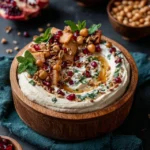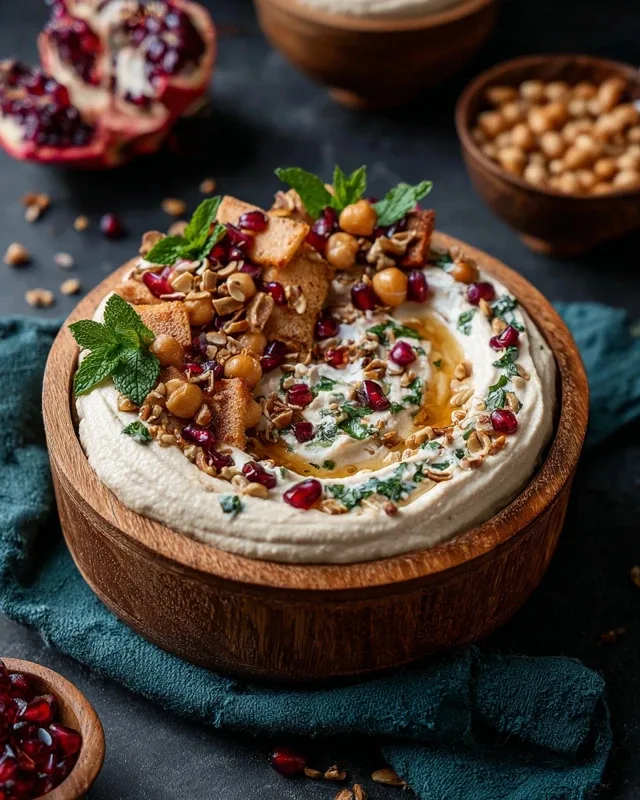When it comes to Middle Eastern cuisine, one dish that stands out for its rich flavors, comforting texture, and cultural significance is Hummus Fatteh. This beloved recipe has been a staple in Levantine households for generations, celebrated during family gatherings, festive occasions, and even simple weeknight dinners. If you’ve ever wanted to bring a true taste of the Levant to your kitchen, learning how to prepare Hummus Fatteh is a delicious and rewarding experience.
In this article, we’ll dive deep into everything you need to know about Hummus Fatteh—from its origins and cultural importance to step-by-step preparation, variations, tips for the perfect texture, and answers to the most commonly asked questions. By the end, you’ll not only be ready to cook it confidently but also to serve it in ways that will impress both family and guests.
What is Hummus Fatteh?
Hummus Fatteh, sometimes referred to simply as Fatteh, is a layered dish that combines toasted or fried pita bread, chickpeas, creamy yogurt-tahini sauce, and crunchy toasted nuts, all brought together with fragrant spices and olive oil.
The word Fatteh comes from the Arabic word fett, meaning “to break into pieces,” which perfectly describes the first step in preparing this dish—breaking pita bread into crunchy bite-sized portions to form the base layer. On top of this base, warm chickpeas and a velvety yogurt-tahini mixture are poured, followed by toppings such as pine nuts, parsley, paprika, or sumac.
This dish is more than just food; it’s a reflection of Levantine culinary heritage. It embodies the region’s love for layering flavors, textures, and aromas into one harmonious plate.
A Brief History of Hummus Fatteh
The origins of Hummus Fatteh can be traced back to the Levant, a region encompassing modern-day Lebanon, Syria, Jordan, and Palestine. Traditionally, fatteh was considered a way to use leftover bread. Families would toast or fry day-old pita and layer it with ingredients they had on hand—chickpeas, yogurt, tahini, and seasonings.
Over time, this humble recipe transformed into a dish of celebration. Today, Hummus Fatteh is commonly served for special breakfasts, weekend family lunches, or as part of a mezze spread during gatherings. Its popularity has spread beyond the Middle East, becoming a favorite among food lovers worldwide who crave authentic Levantine flavors.
Why You’ll Love Hummus Fatteh
There are countless reasons why Hummus Fatteh has earned a permanent spot in Middle Eastern cuisine, and why you should try it at home:
- Comforting and filling – Layers of chickpeas, bread, and yogurt-tahini sauce make this dish hearty and satisfying.
- Simple ingredients – Everything you need can be found in most grocery stores.
- Customizable – From toppings to spices, you can adjust the recipe to match your taste.
- Healthy yet indulgent – Chickpeas and yogurt offer protein and probiotics, while olive oil and nuts add richness.
- Perfect for gatherings – It looks impressive when served and is ideal for sharing.
Once you’ve tried Hummus Fatteh, you’ll understand why it’s often described as a dish that brings people together.
Ingredients for Hummus Fatteh
Here’s what you’ll need to prepare this authentic recipe:
- 2 cups canned chickpeas, drained and rinsed (reserve some for garnish)
- 2 cups plain Greek yogurt
- 1/4 cup tahini
- 3 cloves garlic, minced
- 3 tablespoons lemon juice
- 1 teaspoon cumin
- Salt, to taste
- 2 cups pita bread, cut into pieces and toasted or fried
- 3 tablespoons olive oil
- 1/4 cup pine nuts (or almonds), toasted
- Fresh parsley, chopped (for garnish)
- Paprika or sumac (for garnish)

These simple yet powerful ingredients create a balance of creaminess, crunch, and earthy flavors.
Step-by-Step Instructions
Follow these steps to prepare Hummus Fatteh perfectly every time:
- Prepare the yogurt-tahini sauce
- In a mixing bowl, whisk together Greek yogurt, tahini, minced garlic, lemon juice, cumin, and salt until smooth and creamy. This will serve as the luxurious topping that binds all the layers together.
- Toast or fry the pita bread
- Cut pita bread into bite-sized pieces. Either toast in the oven until golden and crisp or fry lightly in olive oil for a richer flavor. Arrange these pieces at the bottom of your serving dish.
- Add the chickpeas
- Warm the chickpeas on the stove and layer them evenly over the toasted pita bread. For extra flavor, you can sauté them with a little garlic and cumin before adding.
- Layer the yogurt mixture
- Generously pour the yogurt-tahini sauce over the chickpeas, ensuring every bite gets coated with creamy goodness.
- Finish with toppings
- Drizzle with olive oil, sprinkle toasted pine nuts (or almonds), chopped parsley, and a dusting of paprika or sumac for brightness.
- Serve immediately
- Enjoy while the pita is still slightly crunchy, balancing the textures beautifully.
Tips for the Best Hummus Fatteh
To make your Hummus Fatteh truly unforgettable, keep these tips in mind:
- Use day-old pita bread – It holds up better when toasted or fried.
- Balance flavors – Don’t skip the lemon juice and garlic; they cut through the richness of the yogurt and tahini.
- Serve immediately – If the dish sits too long, the pita bread may become soggy.
- Toast nuts carefully – Pine nuts burn easily, so toast them over low heat until just golden.
- Adjust creaminess – If your yogurt-tahini mixture feels too thick, add a splash of water or extra lemon juice.
Variations of Hummus Fatteh
One of the beauties of Hummus Fatteh is its versatility. You can easily adapt it to suit your preferences:
- Meat Fatteh – Add seasoned ground beef or lamb sautéed with onions and spices on top for a heartier version.
- Vegetarian Fatteh – Keep it meat-free with extra chickpeas, roasted vegetables, or sautéed mushrooms.
- Eggplant Fatteh – Roast or fry eggplant cubes and layer them alongside the chickpeas.
- Nut Variations – Use almonds, cashews, or walnuts instead of pine nuts for a different flavor.
- Spiced Butter Drizzle – Melt butter with paprika, cumin, or chili flakes and drizzle on top for an aromatic kick.
Each variation adds a unique twist while staying true to the spirit of Hummus Fatteh.
What to Serve with Hummus Fatteh
While Hummus Fatteh can stand on its own as a filling dish, it also pairs beautifully with other Middle Eastern favorites:
- Fresh salads like tabbouleh, fattoush, or cucumber-tomato salad
- Grilled meats such as chicken kebabs or lamb skewers
- Mezze platters featuring hummus, baba ganoush, and stuffed grape leaves
- Warm pita bread for scooping up extra sauce
For drinks, serve with mint tea, ayran (a yogurt-based beverage), or fresh lemonade to balance the richness.
Nutritional Benefits of Hummus Fatteh
Beyond its incredible taste, Hummus Fatteh is packed with nutritional benefits:
- Chickpeas – A great source of plant-based protein and fiber.
- Greek yogurt – Provides probiotics, calcium, and protein.
- Tahini – Rich in healthy fats, iron, and antioxidants.
- Olive oil – Contains heart-healthy monounsaturated fats.
- Pine nuts – Add vitamin E, magnesium, and additional healthy fats.
This dish offers a satisfying balance of carbohydrates, proteins, and healthy fats, making it a wholesome meal option.
Storage and Make-Ahead Tips
Because Hummus Fatteh is best served fresh, storage can be tricky. However, you can prepare components ahead of time:
- Chickpeas – Cook and refrigerate for up to 3 days.
- Yogurt-tahini sauce – Store in an airtight container for 2–3 days.
- Toasted pita – Keep in an airtight container at room temperature for 1–2 days.
When ready to serve, simply reheat chickpeas, assemble the layers, and add toppings. Avoid storing assembled fatteh as the bread will lose its crunch.
Frequently Asked Questions (FAQs)
1. Can I make Hummus Fatteh vegan?
Yes. Replace Greek yogurt with a dairy-free yogurt alternative, and the dish becomes fully vegan.
2. Can I use dried chickpeas instead of canned?
Absolutely. Soak dried chickpeas overnight, then cook until tender. They often have a fresher taste and firmer texture.
3. Is Hummus Fatteh served hot or cold?
It’s typically served warm, with hot chickpeas layered over crispy pita and topped with cool yogurt-tahini sauce.
4. Can I substitute pine nuts?
Yes. Almonds, cashews, or walnuts work well as substitutes, depending on what you prefer.
5. What makes Hummus Fatteh different from regular hummus?
Unlike traditional hummus, which is a smooth dip, Hummus Fatteh is a layered dish with bread, chickpeas, yogurt sauce, and toppings.
Conclusion
Hummus Fatteh is more than just a recipe—it’s a tradition, a comfort food, and a celebration of Levantine flavors. With its layers of crispy pita, hearty chickpeas, creamy yogurt-tahini sauce, and nutty garnish, it delivers a perfect balance of textures and tastes in every bite. Whether you’re preparing it for a family gathering, a festive occasion, or simply to enjoy a nourishing meal at home, Hummus Fatteh is a dish that never disappoints.
By following this guide, you now have everything you need to make authentic Hummus Fatteh at home. Try different variations, experiment with toppings, and make it your own. Once you serve it, you’ll see why this dish has been cherished for centuries—and why it deserves a place in your kitchen today.
Print
Hummus Fatteh Recipe – A Traditional Levantine Comfort Dish
Ingredients
-
2 cups canned chickpeas, drained & rinsed (reserve some for garnish)
-
2 cups plain Greek yogurt
-
1/4 cup tahini
-
3 cloves garlic, minced
-
3 tbsp lemon juice
-
1 tsp cumin
-
Salt, to taste
-
2 cups pita bread, cut into pieces & toasted or fried
-
3 tbsp olive oil
-
1/4 cup pine nuts (or almonds), toasted
-
Fresh parsley, chopped (for garnish)
-
Paprika or sumac (for garnish)
Instructions
-
In a bowl, whisk together yogurt, tahini, garlic, lemon juice, cumin, and salt until smooth and creamy.
-
Arrange toasted pita pieces in the bottom of a serving dish.
-
Layer with warm chickpeas over the pita.
-
Pour the yogurt-tahini mixture generously on top.
-
Drizzle with olive oil, then sprinkle with toasted pine nuts, parsley, and paprika or sumac.
-
Garnish with extra chickpeas if desired.
-
Serve immediately while the pita is still slightly crunchy and enjoy this Levantine comfort food!
